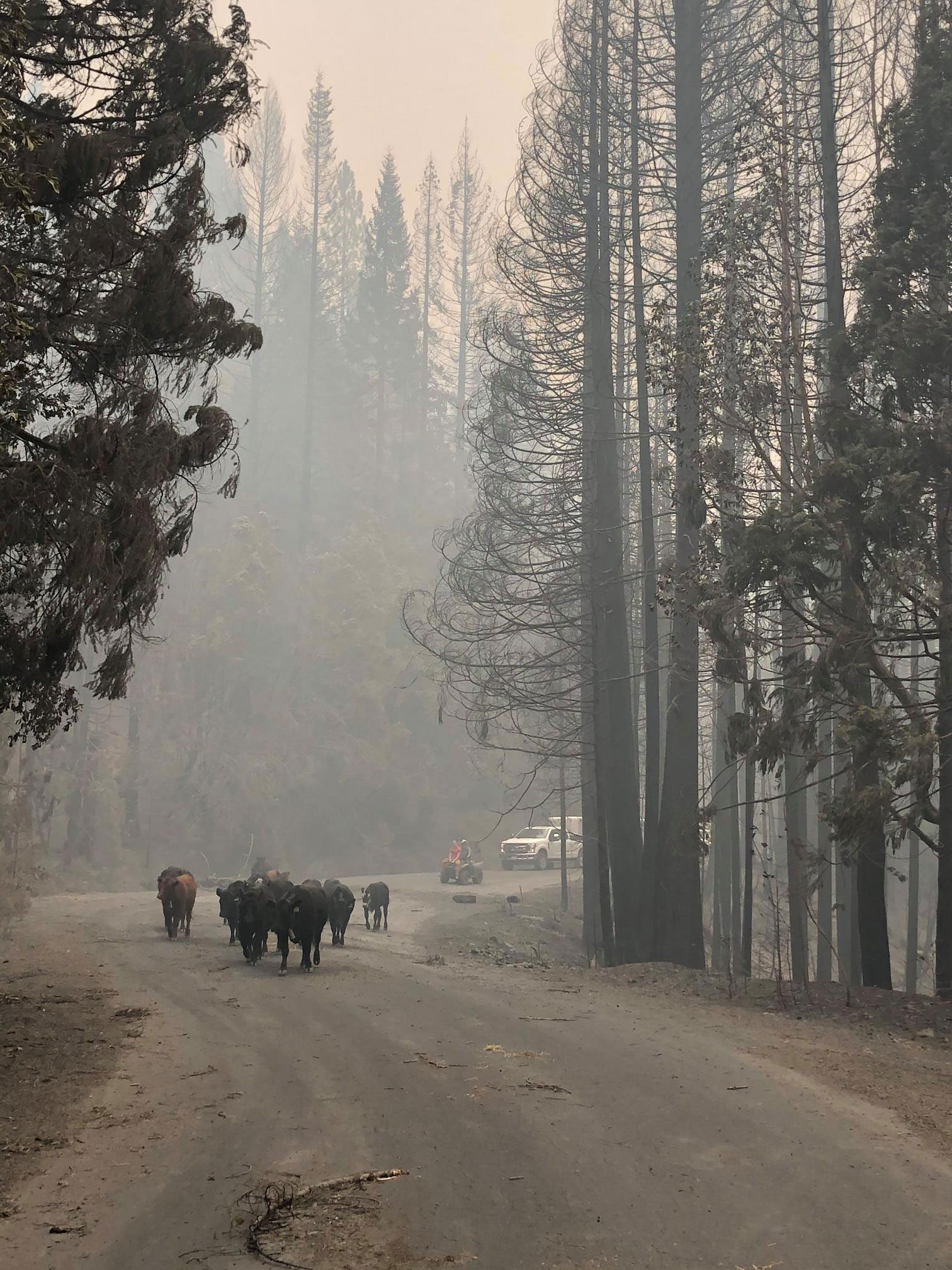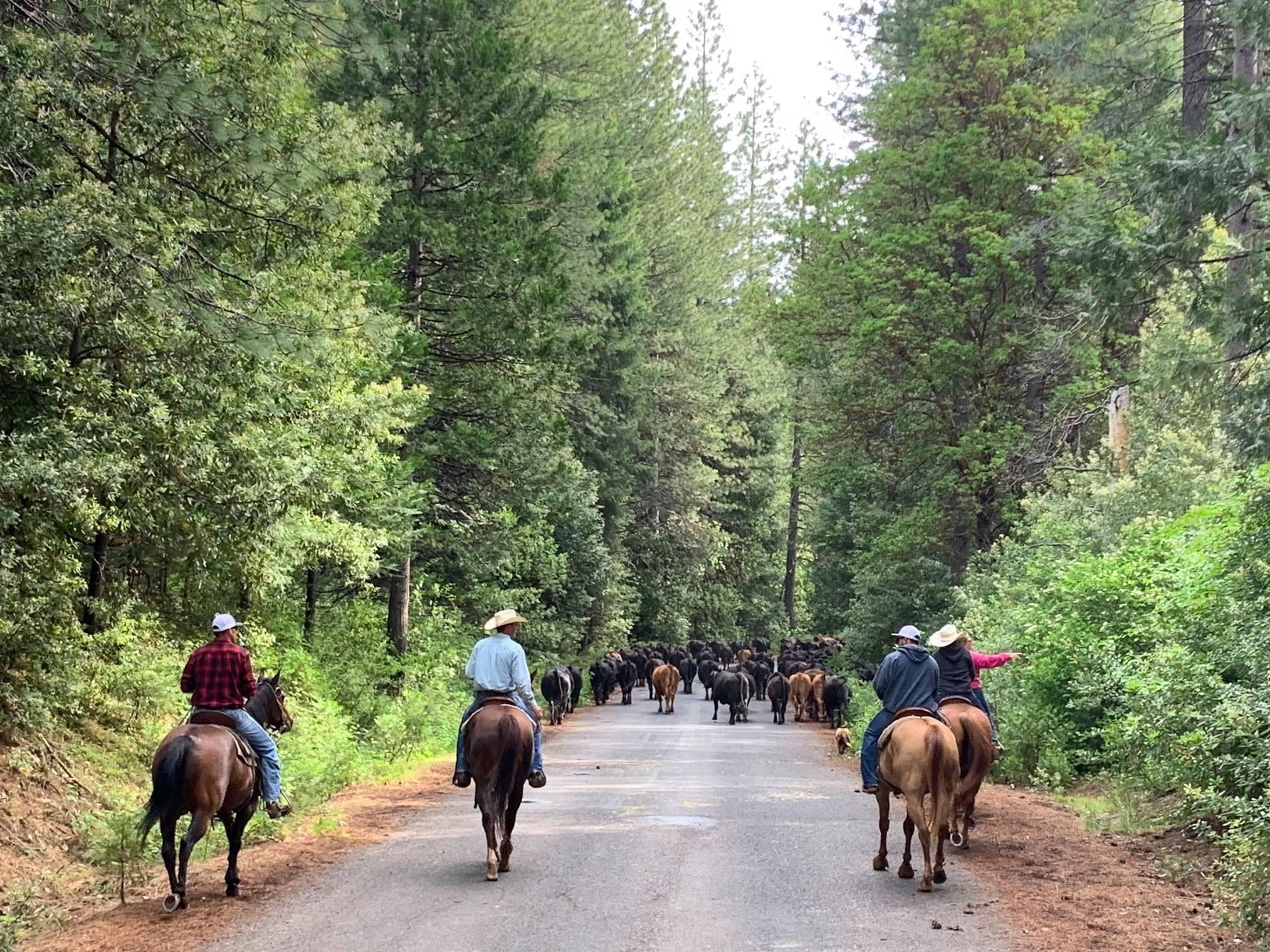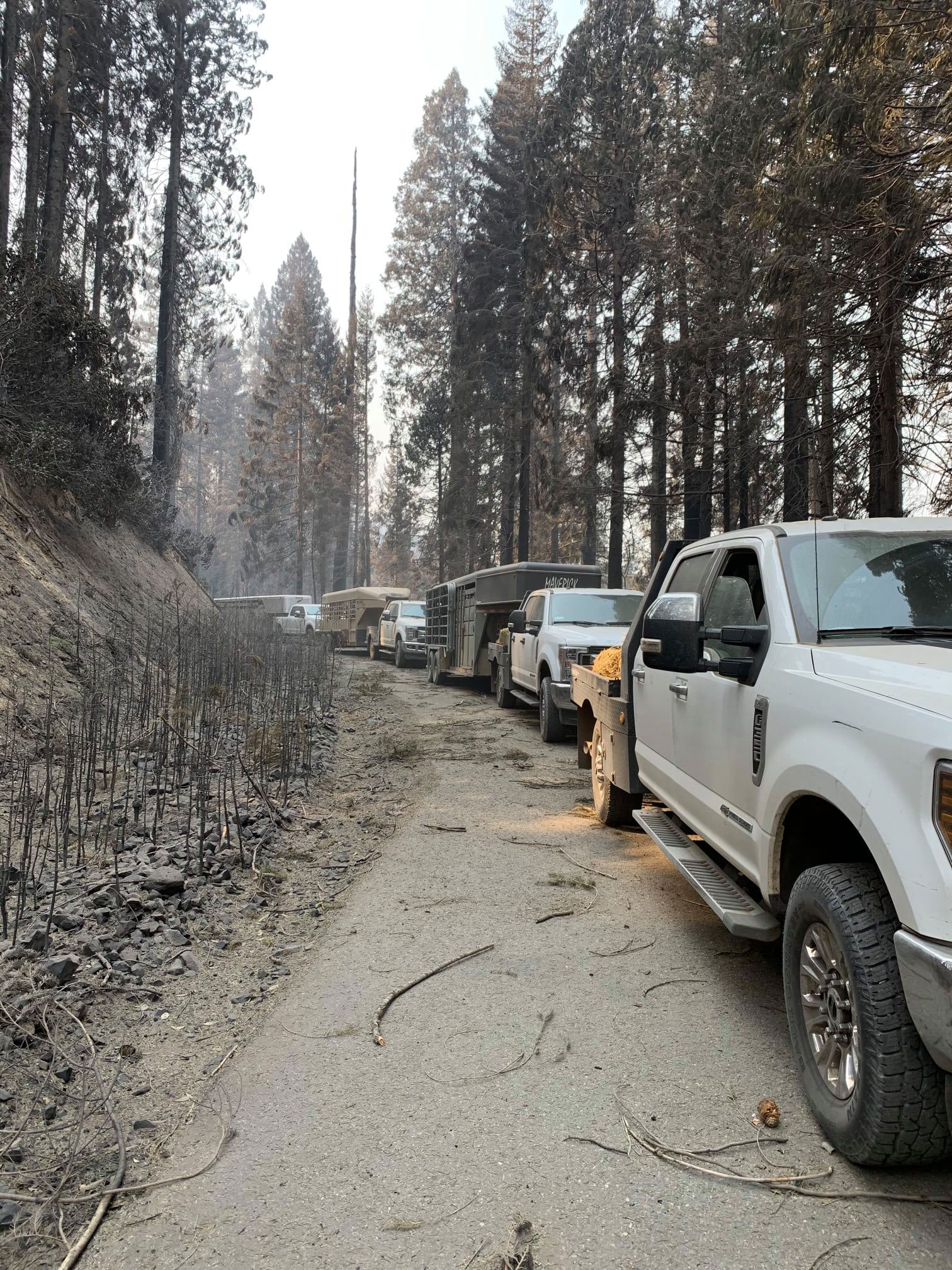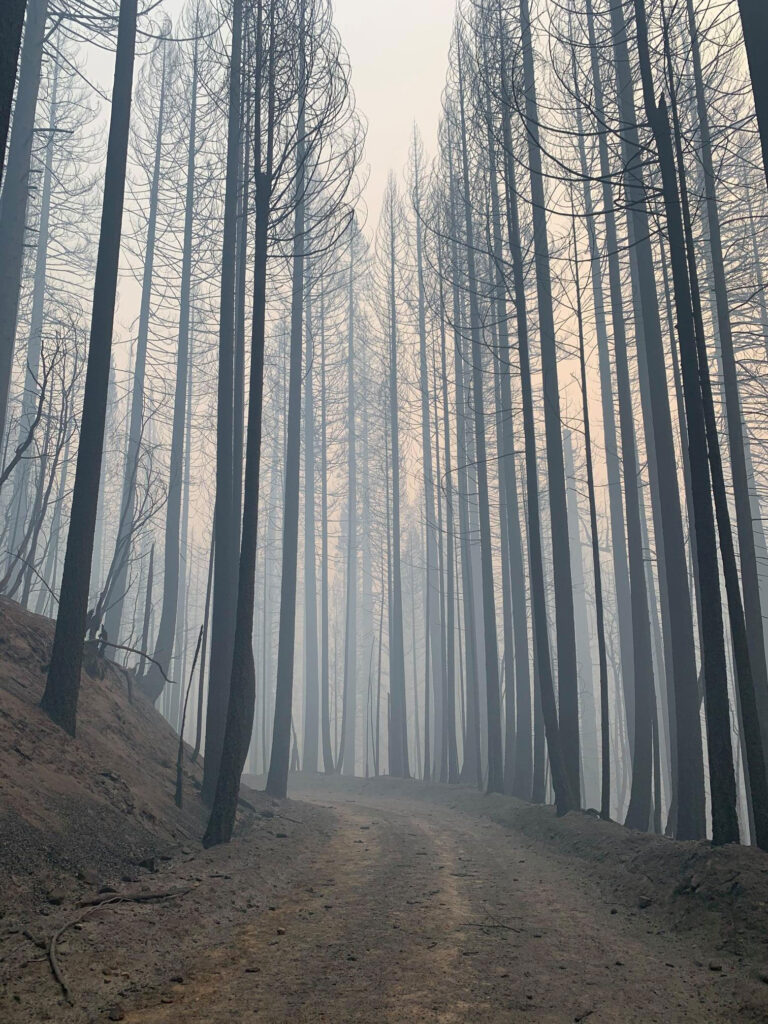Requiem for a Forest
By Dave Daley, Butte County Rancher & CCA Past President
Follow up to “I cry for the mountains and the legacy lost | The Bear Fire” from Sept. 2020
 It has taken months to garner the courage to return to our summer cattle range in the Plumas National Forest. Six generations have taken cattle to the Sierra Nevada high country east of Oroville for over 150 years, on both public (U.S. Forest Service) and private timber company lands owned by Sierra Pacific Industries. The land was completely destroyed by the North Complex fire (Bear Fire) in early September. The devastation was indescribable. We lost close to 350 cows and their baby calves. Burned alive, running from a raging inferno that destroyed all life. We found dead cows and small calves, and very few alive, in desperate conditions that I can never forget. I wish I could. (https://calcattlemen.org/2020/09/23/legacy/ ). The horror that all living things must have experienced impacted me to the core. We saw dead and severely burnt bears and cubs, bucks, does and fawns, fox, squirrels, chipmunks, ….and the list goes on…and so many species of birds. One hopes they died quickly.
It has taken months to garner the courage to return to our summer cattle range in the Plumas National Forest. Six generations have taken cattle to the Sierra Nevada high country east of Oroville for over 150 years, on both public (U.S. Forest Service) and private timber company lands owned by Sierra Pacific Industries. The land was completely destroyed by the North Complex fire (Bear Fire) in early September. The devastation was indescribable. We lost close to 350 cows and their baby calves. Burned alive, running from a raging inferno that destroyed all life. We found dead cows and small calves, and very few alive, in desperate conditions that I can never forget. I wish I could. (https://calcattlemen.org/2020/09/23/legacy/ ). The horror that all living things must have experienced impacted me to the core. We saw dead and severely burnt bears and cubs, bucks, does and fawns, fox, squirrels, chipmunks, ….and the list goes on…and so many species of birds. One hopes they died quickly.
The watershed that fills Lake Oroville, 3.5-million-acre-feet and one of the largest manmade lakes in the world, is nothing but black rubble. Majestic pines and firs, towering black oak and madrone. Dead. Silent sentinels of the land that once was. The impact of this catastrophe is not just on me and my family, or those who work and recreate in the forest, or on tourism and business in the town of Oroville. This devastation impacts all Californians who value access to clean water and abundant food.
Since we finished the hunt in October for any cattle that may have survived, I had only ventured to the mountains one time to find a Christmas tree on the outer edge of the fire complex, a tradition our family has enjoyed for years. In mid-December most of the ground was covered with snow and it was snowing hard. The palette of white and grey softened the harsh reality of “move-on, nothing left to see here.” Nothing to see at all. Just death.
But it is April, and a time when life begins anew. My Dad and his Dad before him always tried to take a trip “to the hills” in April or May to get a sense of what may lie ahead when we would trail our cattle to the mountains in early June. Washed out roads, downed trees, plugged culverts, places where you might not get a truck through. Always something. And was the range ready for the cows? Every year was different, from snowbanks blocking the roads in early July to a dry year with very little snow. But this time the trip would be more than difficult. A major drought with very little snowpack, likely not even covering scars from a catastrophic fire. I wonder what, if anything, is left? I dreaded the thought.
In my dreams the mountains are sometimes green and lush with the thick canopy of conifers, sprinkled with hardwoods and browse. What I remember, long for, and will forever miss. Teeming with wildlife that are at home in this wildland, part of a mosaic of nature that transcends our brief time on the land. And other nights it is the nightmare of searching for cows in deep canyons choked with smoke. Only to find them in piles of decaying, charred flesh as they rushed to water desperate to escape.
This time I saw nothing alive. Not even a bird. And it wasn’t a dream. If only.

The night before I left, I debated whether to pick up my 90-year-old mother for a quick ride, not sure if she wanted a first-hand reminder of the place where she spent her summer and fall over the past 72 years. Side by side with my Dad, raising kids and grandkids, gathering cattle, and observing the beautiful cycle of nature. So I called and asked “do you want to take a quick trip to the mountains tomorrow morning?” Without hesitation, “Of course. What time will you be here?” And by her not-so-subtle implication, “you ought to get here by daylight, that’s when your Dad and I always started!” Bright, sharp as a knife off a freshly used whetstone, and always ready to go. That is Mom. It is comforting to know that the routine of “leave before the sun rises” has not been dampened by time.
I had a few hours before I needed to get back to the valley to attend two funerals, so I made the decision to take a fast trip and at least cover the low end of the range. I quickly made it to the remnants of the town of Feather Falls, once a bustling community with a church, store, and school of eighty plus students and four teachers (two grades per classroom). Feather Falls was a busy little place. A mill town for sure, mostly loggers, miners, and a few government employees. I remember our cow drive through the center of “town,” where everyone turned out to watch each spring. The village died when the mill left and moved to Oroville.
 After a 50-year hiatus, Feather Falls is a bustling logging camp again, with 60-plus camp trailers for loggers who have become the undertakers for this morgue. Good people. I talked to a few on the road. They are part of the timber community and appreciate the work. But not like this. Black, charcoal bark and ash day after day, trying to salvage value from an inferno that man helped create. The “townsite” is simply a flat spot in the mountains with a water supply, right at the entrance to the cattle range. I remember all the homes, the lumber mill, shops, and railroad, gradually replaced by pine trees after the town died. Now it is barren, black with ash and desolate.
After a 50-year hiatus, Feather Falls is a bustling logging camp again, with 60-plus camp trailers for loggers who have become the undertakers for this morgue. Good people. I talked to a few on the road. They are part of the timber community and appreciate the work. But not like this. Black, charcoal bark and ash day after day, trying to salvage value from an inferno that man helped create. The “townsite” is simply a flat spot in the mountains with a water supply, right at the entrance to the cattle range. I remember all the homes, the lumber mill, shops, and railroad, gradually replaced by pine trees after the town died. Now it is barren, black with ash and desolate.
Funerals are hard and devastating to family and friends, especially when people were far too young like those I went to today. I saw that this afternoon. But in the back of our minds, we know the time will come for all of us. Tragic, unexpected, difficult, but a chance to reflect and bring closure and healing. This monstrous fire was a funeral of a different sort. No closure. No healing. No time to move on. Just a black encrusted, gaping wound in ridge after canyon after ridge as far as you could see. It is not a scar yet. Not by a long shot. Maybe it never will be healed? Small trickles of water form from springs covered with ash and debris. The gray-colored scum is the purge of nature’s horrid wound. Will it ever heal? You hunt for a green fir or pine among the blacks and greys. Few and far between, but you see them occasionally along a watercourse or where they escaped the devastating wind. And you hope they make it. The scorched earth has yet to show signs of germination. The fire burned so intensely that I wonder when and if the rebirth will begin?
Unfortunately, it seems to take tragedy to generate change. Not just based on my experience but on similar fire devastation throughout the state – homes, businesses, and lives in the Camp Fire, the August Complex, the Creek Fire, the Tubbs fire, the Thomas Fire. The list of tragedies is endless. But I finally hear voices of reason and common sense being amplified in Sacramento and in Washington, DC. Why does it take tragedy first? People seem to recognize that there are tools that can reduce the intensity of wildfire – not stop them, but perhaps keep them from becoming catastrophic. I am finally hearing “put good fire on the ground as prescribed fire when conditions are right,” something our ancestors knew forever. And “reduce fuel loads with grazing or other management strategies; we must reduce fuel loads when we can.”
As I see it, talk is cheap. Many of us have known solutions for decades but were not allowed to implement them. Regulations and fear have stopped any efforts to mitigate these disasters stone cold. We continue to make it worse. Can the sheer scope of these catastrophes create enough momentum to overcome the inertia that drags state and federal government into a morass of regulations and an unwillingness to do anything different?
Well, what we are currently doing isn’t working! Unfortunately, I am afraid we will form a study group with highly paid experts to discuss the problem. It is disappointing at best, criminal at worst. Fire season approaches quickly. I hope 2021 is not a repeat performance. But I am not optimistic. Government: slow, cumbersome, and rarely effective, even when there is an effort to do the right thing! Discussion is rampant and impassioned. Action is limited.
It is difficult to orient oneself to a place you have always known when everything you knew is gone. “Is that Rogerville we passed or Old Lumpkin?” With all the trees gone, the world feels upside-down. Every landmark we knew has been burnt beyond recognition. And it isn’t just me. My Mom, who has an incredible sense of place, was baffled as well. We would slow and look for some sign of the past. She learned the place names from my Dad, but also his Father and all the “old-timers.” People who loved this land from the late 1800s who were friends and family when my Dad and Mom were married in 1948. It will take careful stewardship to not let the names and the deep history they represent disappear forever.
Sierra Pacific Industries (SPI) is actively logging, removing all the dead timber as quickly as they can, hoping to salvage some value before the rot sets into the dead trees. There are literally 100s of loads of logs per day coming off the range, through the town of Oroville and to mills throughout the north state. There is a massive amount of timber to be harvested. Unfortunately, the closing of lumber mills has left few options. The loss of jobs and businesses has devastated so many communities. So now the logs must be hauled further. And SPI is already beginning to replant. I have heard them estimate planting over three million trees per year for the next three years. An ambitious and critically important project!
Our cattle range is a checkerboard of private SPI land and the Plumas National Forest, managed by the federal government. Most of the lower elevation of the allotment is SPI and the upper reaches of the range are federal. In contrast to the rapid timber harvest on private ground, I see no activity by the Forest Service. Bureaucracy cripples action. SPI has navigated the complex California timber harvest regulations and is moving quickly. The dense and dead forest of federal lands have not been touched as far as I can see. I’m sure there is an effort to move but layers of regulations make federal action next to impossible.
 As we traveled up Lumpkin Ridge, it does not get better. Admittedly, April is a little early so I am hoping that more signs of life will be evident in the next couple of months. Past the Farnam Pitch, Dodge Camp, the Burma Road, and on towards Davis Creek. We finally hit snow at about 5200 feet, just a light skiff on the sides of the road. It should be four feet deep in April. As we pass McNair Saddle the snow starts to deepen, and we moved from mostly private land of SPI on to the Plumas National Forest.
As we traveled up Lumpkin Ridge, it does not get better. Admittedly, April is a little early so I am hoping that more signs of life will be evident in the next couple of months. Past the Farnam Pitch, Dodge Camp, the Burma Road, and on towards Davis Creek. We finally hit snow at about 5200 feet, just a light skiff on the sides of the road. It should be four feet deep in April. As we pass McNair Saddle the snow starts to deepen, and we moved from mostly private land of SPI on to the Plumas National Forest.
I must get back and I think the snow will stop me soon. Next time I will go higher, although I find myself dreading that already. I worry about my kids and their friends who grew up in this forest having to witness this again. It quite literally takes your breath away. This is incredibly hard for me and for my Mom but thinking about the next generations, especially my granddaughter Juni, and what they will miss is what haunts my sleep with a pit in my stomach. Sadness, anger, frustration, fear of the future, and a slim ray of hope for change all in a tightly wound ball of angst. Right in my gut.
And all we have for now are the memories and the stories and the strength of family and character that says “Don’t quit, never quit, it is too important to the fabric of who you are and who the generations to come will be. Work with nature. Understand and value your heritage and those who came before who loved the land as well.” And my Mom with her grit and gristle: “you have seen the worst, it will only get better.” That must be our touchstone as the year continues to unfold.
Photos courtesy of the Daley family.

